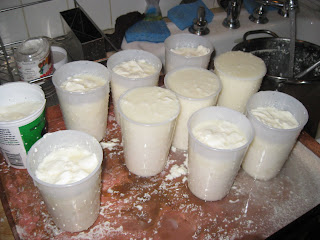This morning I went to get some milk at the Holstein farm. Usually I get there just at the end of milking time and have a little chat with the farmer. Although I was there at the regular time, the farmer had finished milking. After I had filled up my jugs from the bulk tank, I went to look for the farmer in the barn.
It was cold in upstate New York, so the cows were inside. I did not see the farmer but my eyes fell on a curious site. Near the entrance I saw one cow lying down. A glob was coming from it's behind. I walked towards it and soon realized that the cow was calving. Having heard a lot about possible complications during calving and noticing no movement of the calf which was half sticking out, I went to look for the farmer. I went to the house. He wasn't there, but his wife was. She mentioned he was expecting the cow to calf but had thought it wouldn't be so soon. He had gone up the hill to hunt for some deer.
We went back to the barn where the calf was almost entirely extracted from the cow. Just a quarter of it's hind legs were still inside. The farmer's wife grabbed the front legs and pulled the calf. It came out without any problem and it was soon clear that the calf and the mother were fine. She pulled the calf around the other cows toward the front of the mother. There she laid it on some hay and, what seemed like, massaged the heart a little and gave it some encouraging talk to get up. The mother, who seemed exhausted, licked the newborn and ate the umbilical cord. To the delight of the farmer's wife, the newborn was a heifer.
Writing this back in Brooklyn while making cheese from the milk of the fellow cows, I can't but help thinking while living in the city how fortunate I am, I can experience this. It makes me very happy.

















































